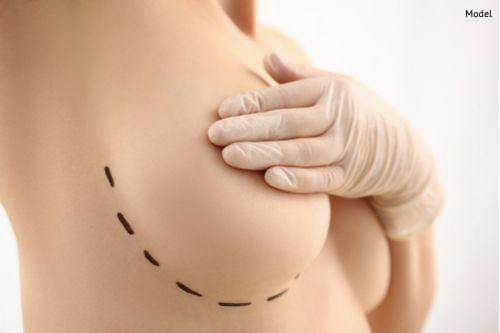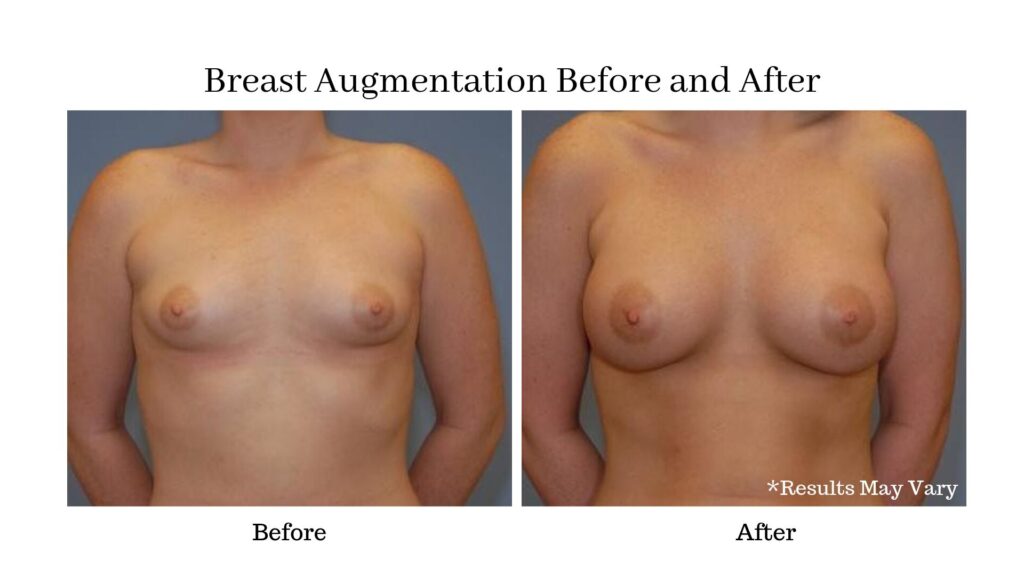6 minute read
No one wants to hear there is a possibility they will need revision surgery before getting started on their initial procedure. Unfortunately, that is a risk that all patients must accept prior to undergoing a plastic surgery procedure like breast augmentation.

Female hand in gloves holding breast closeup.
Breast augmentation uses synthetic implants filled with silicone gel or saline to add volume, define shape, correct asymmetry, and balance the breasts with the rest of your physique.
Breast augmentation is a popular cosmetic surgery, so it makes sense that this surgical option would have a fair amount of revision cases.
In 2018, nearly 30,000 women decided to remove their implants. While this sounds like a high number, it is dwarfed by the nearly 314,000 women that chose to get implants during the same time frame.
What Is Breast Revision?
Breast revision is performed when women need or want to remove their breast implants. Just as there are different reasons to undergo breast revision, there are different revision techniques performed to restore breast health and breast aesthetics.
Will I Need Breast Revision?
Unfortunately, there is no set percentage or statistic saying if a woman will need breast revision surgery. It is difficult to estimate the health or longevity of your implants, and it is impossible to know if your aesthetic desires will change down the line.
Breast revision is required when there is a complication with an implant, but it is also an option for women who want to downsize their implants, increase the size of their implants, or remove them permanently.
Why Would I Choose Breast Revision?
 Capsular Contracture
Capsular Contracture
While still very rare, capsular contracture is the most commonly experienced breast complication. When it occurs, breast revision relieves the discomfort and stress placed on the implant.
Scar tissue, which forms around any foreign object placed in the body, causes capsular contracture.
In the case of breast augmentation, the tissue forms a capsule around the implant, whether it is saline or silicone, and usually stays in place without any complications. Occasionally, this capsule tightens and squeezes the implant. Capsular contracture causes a sharp pain after breast augmentation and a distorted breast aesthetic.
Capsular contracture is relieved through breast revision. The implant and affecting scar tissue will be removed, and a replacement implant will be added. This implant can be an identical model, or it can be a different size, shape, profile, or material.
Implant Rupture
Breast implants are durable and able to withstand a significant amount of pressure.
Unfortunately, severe trauma and normal wear-and-tear weaken the shell of the implant. Occasionally, the shell will split open, and you are left with a ruptured breast implant.
The body will absorb saline over a few hours, whereas silicone can remain in the breast pocket for weeks, months, and even years before making its way into the body.
A ruptured implant must be handled as soon as possible. While a saline rupture will be readily noticeable, many silicone ruptures are “silent” and are only diagnosed through an MRI or ultrasound.
This is why it is recommended to undergo routine MRIs or ultrasounds every two years to verify the health of the implant.
Implant Displacement
Implants should remain in this breast pocket for the duration of the implant’s life. Sadly, this does not always work as it should.
The implant can fall to the side of the breast (to create an undesirable aesthetic) or below the inframammary line to create a condition known as double bubble deformity. Double bubble deformity creates a rippled appearance in the breast.
While this complication needs to be repaired with revision surgery, it does not always require the removal of the implant. A capsulorrhaphy can be performed to correct the breast pocket and surrounding tissue, and reposition the displaced implant.
Changes in Aesthetic Desire or Lifestyle
Sometimes, the idea of bigger breasts sounds like a fantastic idea in your twenties. Unfortunately, that enthusiasm does not always continue into your forties or fifties.
The breasts change naturally with time, pregnancy, and weight fluctuation. The look your implants give you at age twenty may not be the same look you are hoping to convey at age fifty.
Fear of Your Implants
Unfortunately, the number of breast revisions is likely to grow in the coming years because of concern over breast implant safety.
Breast implants are safe. They are not linked to breast cancer in any way, and treatment for breast cancer can still be performed with implants. Sadly, some women are still worried.
Much of this concern stems from a recent report released by the FDA and Allergan™—one of the manufacturers of breast implants. This statement reported a rare link between a specific textured Allergan™ implant and breast-implant associated anaplastic large-cell lymphoma (BIA-ALCL).
While BIA-ALCL is cancer, it is not breast cancer and is easily treated when diagnosed early. This disease causes swelling and pain in the breast and can be dangerous when ignored.
This condition is only linked to textured breast implants, which Dr. Mockler does not offer at his practice. If you received these implants with another plastic surgeon, and are interested in learning about your options, schedule a consultation with Dr. Mockler. Breast revision will likely only be necessary if you are physically experiencing complications.
If I Experience Any of These Conditions, What Are My Options?
Any sign of a breast implant problem should never be ignored. If you are concerned about the health of your implant, see your doctor right away.
Breast revision consists of one of the following options: permanent removal of the implant, replacement of the implant, or correction of the implant (usually correction of the tissue around the implant so that the implant remains where it should be in the breast pocket).
One of these choices will be selected for your breast revision consultation based on your specific needs and desires. A breast lift may be combined along with breast revision if there is breast ptosis before or after the implant is removed.
Find Out More
To learn more about breast revision near you, contact Dr. Mockler at Panama City Plastic Surgery by calling (850) 769-7270 or by filling out our online contact form.
